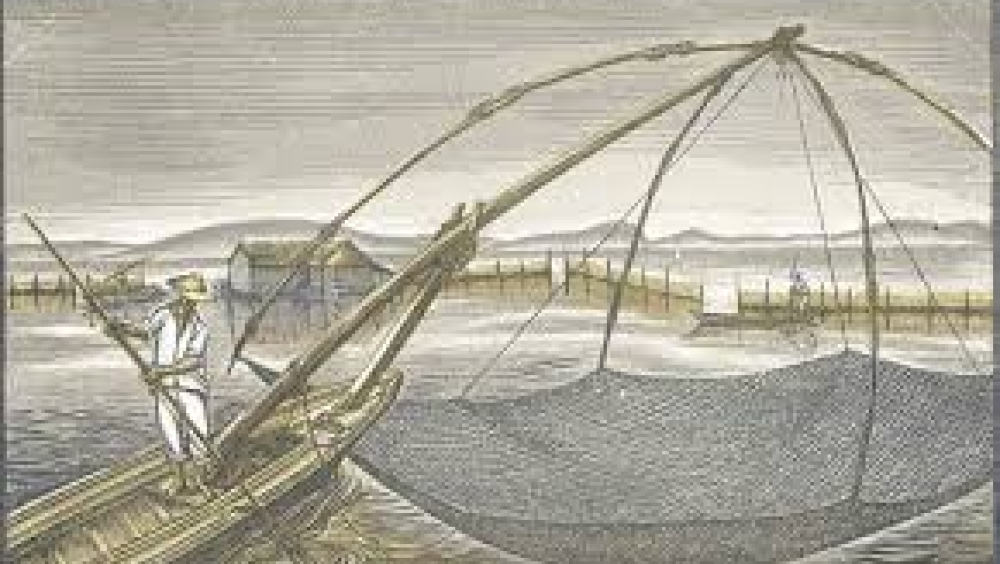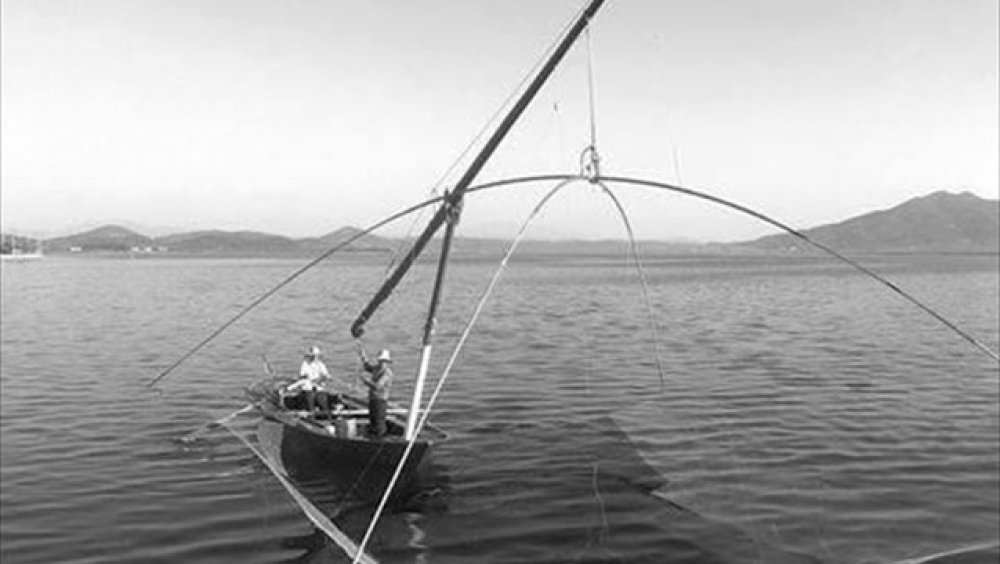Fishing with Stafnokari in the Aitoliko lagoon
Aitoliko is a tiny island in a lagoon forming part of the great wetlands of southwestern central Greece, towards the Ionian Sea. The area was of strategic importance since antiquity, as a key stronghold of western Greece. Local communities lived mainly off fishing and trade. Fishing provided their everyday food, as the lagoon was a natural habitat for several kinds of fish, including mullet and sea bream. Stafnokari was developed as a way of catching large quantities of fish, by simply throwing a net hanging from a small wooden crane on the edge of the fishing boat called priari. This type of fishing is completely harmless for the environment, as it doesn't involve scraping the sea bottom. The method is attested as far back as 1500 A.D., although it is possible that it preserves a much older practice.
When people inhabited the little island on the lagoon, some time in the early modern period, they had little means of subsistence. Whereas nearby Messolonghi was already developing into a sea trade post, Aitoliko (or Anatoliko as they used to call it) was not as favoured geographically, as the distance to be covered to the Ionian Sea was larger. Yet, Mother Mary was explicit: her icon, discovered on the eastern bank of the lagoon, was a good omen for the new settlement. The locals depended on fishing for their daily provisions. The lagoon was very generous: fish was procreating by millions in the warm and shallow waters. With proper preservation in salt, fish could not only feed them and their families, but be exported and sold in other markets, to provide them with money for the rest of their needs. Initially, fishing was quite primitive: from canoes people used to fish with a hook or lance. But the increase in demand in combination with the ingenious mind of the locals, soon gave birth to an innovative fishing method, the "stafnokari". Using as fishing boat a flat barque, called "priari", they fastened a wooden crane on its stern. On that stern they adjusted a flat net, hanging from the four corners with ropes. When empty, the net goes easily in the sea. The fisherman spreads a bit of bait on the net's surface, usually bread mixed cheese. The best days for this kind of fishing are windy ones, when the water is blurred and murky. Then, the fish is blinded and doesn't see the net's eyes. As soon as fish gathers above it, however, the crane lifts it with a sudden move and the fish is trapped and brought aboard. The empty howl of the priari receives the catch and the stafnokari can be thrown again in the water for another batch of fish. Each time it comes up, at least 50 kilos of fish is caught. The best time to fish is early in the morning or in the late afternoon. These are the most picturesque hours in the lagoon, when the slant rays of light paint the water orange and purple and a slight fog hangs above the water.
Vasso used to stare at the priaria standing aloof on the still water as she went out of her house on the sea front. Her brother called her in vain to join him in looking for little crabs. Vasso's gaze was simply caught by the view of the boats with the fishing gear of stafnokari, resembling sea birds looking for prey. Every time the net was thown in the sea, she clapped her hands instinctively. She couldn't tell what was it that made stafnokari a magnetic field for her attention. She just felt an empathetic connection with generation after generation of fishermen, with their eagerness to fill their boat with fish and feed their family. She could even feel a mixture of triumph for the full net and pity for the vanquished, deceived creatures that filled it. It was the same mixed emotions that the fishermen felt. That's why they whispered a prayer every time they threw the net in the lagoon. The picture of stafnokari remained in Vasso's mind so vivid, that she carried it always with her. Throughout her life, when she studied arts in Athens, when she fought against the Germans, when she was exiled for her political beliefs, the picture kept her company as a token of serenity. And when all this was over, when she was not just Vasso, but Vasso Katraki, already recognized as one of the best Greek engravers, she managed to depict it on a piece of wood and print it for people to share her love for her hometown. Nowadays, stafnokari is getting washed away by machine methods of fishing and by modernizaton. The tradition is gruadually fading. No family can depend on fishing to make a living any more. Only one shipyard is left to construct shallow boats for the lagoon, gaites and priaria. The last fishermen of stafnokari perish one after the other. The method has passed on to the list of intangible cultural heritage of Greece. Yet, there is some hope for the future: stafnokari can become a pole of attraction for visitors, eager to leave behind the hassle of big cities and experience real life. The boats now exhibited in the small museum by the western bridge of Aitoliko can be replicated to carry visitors and the works of art created throughout the years inspired by stafnokari and the lagoon can be used for storytelling. One way or another, stafnokari will survive.
Traditional fishing methods are waning everywhere in Europe, although fishing has been for centuries a primary sector occupation which aided the subsistence of millions of people. Although all European lagoons (Camargue and Thau in France, Patok and Karavasta in Albania, Mar Menor in Spain, the extended complex of Venice lagoons in Italy etc) have their own fishing systems, few of them have been officially recognised as Intangible Heritage on an international level. The origin of Stafnokari is unclear. The proximity of Aitoliko and Messlonoghi to the Ionian Sea, for centuries under the control of Italian and particularly Venetian forces, could lead to the suggestion that the method was imitated after Italian precepts. However, no secure proof lives to this day. It is, rather, the modern title of Aitoliko, "little Venice", attributed to it after the construction of multiple-arched bridges in the 19th century, that makes the allusion to Italian origin of this particular fishin method. However, what actually constitutes European added value is the fact that stafnokari is a non-destructive, eco-friendly fishing method, totally compatible to the natural environment, which used to be the basis of existence for about 60-70 families of local fishermen in the post-WWII period (probably more earlier). Although Aitoliko is a small town, throughout the late 19th-early 20th century, it controlled a considerable number of large trade vessels, hence its products, notably salted fish and botargo, caught in this method, could reach easily the European markets.

